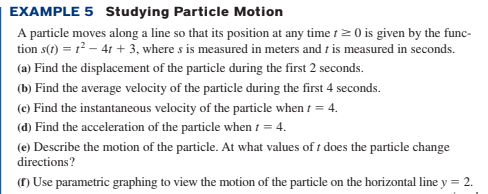EXAMPLE 5 Studying Particle Motion A particle moves along a line so that its position at any time tz 0 is given by the func- tion s(t) = r – 41 + 3, where s is measured in meters and t is measured in seconds. (a) Find the displacement of the particle during the first 2 seconds. (b) Find the average velocity of the particle during the first 4 seconds. (e) Find the instantaneous velocity of the particle when t = 4. (d) Find the acceleration of the particle when 1 = 4. (e) Describe the motion of the particle. At what values of t does the particle change directions? (1) Use parametric graphing to view the motion of the particle on the horizontal line y = 2.
EXAMPLE 5 Studying Particle Motion A particle moves along a line so that its position at any time tz 0 is given by the func- tion s(t) = r – 41 + 3, where s is measured in meters and t is measured in seconds. (a) Find the displacement of the particle during the first 2 seconds. (b) Find the average velocity of the particle during the first 4 seconds. (e) Find the instantaneous velocity of the particle when t = 4. (d) Find the acceleration of the particle when 1 = 4. (e) Describe the motion of the particle. At what values of t does the particle change directions? (1) Use parametric graphing to view the motion of the particle on the horizontal line y = 2.
College Physics
1st Edition
ISBN:9781938168000
Author:Paul Peter Urone, Roger Hinrichs
Publisher:Paul Peter Urone, Roger Hinrichs
Chapter3: Two-dimensional Kinematics
Section: Chapter Questions
Problem 54PE: Near the end of a marathon race, the first two runners are separated by a distance of 45.0 m. The...
Related questions
Question

Transcribed Image Text:EXAMPLE 5 Studying Particle Motion
A particle moves along a line so that its position at any time tz 0 is given by the func-
tion s(t) = r – 41 + 3, where s is measured in meters and t is measured in seconds.
(a) Find the displacement of the particle during the first 2 seconds.
(b) Find the average velocity of the particle during the first 4 seconds.
(e) Find the instantaneous velocity of the particle when t = 4.
(d) Find the acceleration of the particle when 1 = 4.
(e) Describe the motion of the particle. At what values of t does the particle change
directions?
(1) Use parametric graphing to view the motion of the particle on the horizontal line y = 2.
Expert Solution
This question has been solved!
Explore an expertly crafted, step-by-step solution for a thorough understanding of key concepts.
This is a popular solution!
Trending now
This is a popular solution!
Step by step
Solved in 2 steps

Recommended textbooks for you

College Physics
Physics
ISBN:
9781938168000
Author:
Paul Peter Urone, Roger Hinrichs
Publisher:
OpenStax College

Physics for Scientists and Engineers: Foundations…
Physics
ISBN:
9781133939146
Author:
Katz, Debora M.
Publisher:
Cengage Learning

Physics for Scientists and Engineers, Technology …
Physics
ISBN:
9781305116399
Author:
Raymond A. Serway, John W. Jewett
Publisher:
Cengage Learning

College Physics
Physics
ISBN:
9781938168000
Author:
Paul Peter Urone, Roger Hinrichs
Publisher:
OpenStax College

Physics for Scientists and Engineers: Foundations…
Physics
ISBN:
9781133939146
Author:
Katz, Debora M.
Publisher:
Cengage Learning

Physics for Scientists and Engineers, Technology …
Physics
ISBN:
9781305116399
Author:
Raymond A. Serway, John W. Jewett
Publisher:
Cengage Learning

Principles of Physics: A Calculus-Based Text
Physics
ISBN:
9781133104261
Author:
Raymond A. Serway, John W. Jewett
Publisher:
Cengage Learning